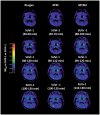Parametric methods for [18F]flortaucipir PET
- PMID: 30569813
- PMCID: PMC7044757
- DOI: 10.1177/0271678X18820765
Parametric methods for [18F]flortaucipir PET
Abstract
[18F]Flortaucipir is a PET tau tracer used to visualize tau binding in Alzheimer's disease (AD) in vivo. The present study evaluated the performance of several methods to obtain parametric images of [18F]flortaucipir. One hundred and thirty minutes dynamic PET scans were performed in 10 AD patients and 10 controls. Parametric images were generated using different linearization and basis function approaches. Regional binding potential (BPND) and volume of distribution (VT) values obtained from the parametric images were compared with corresponding values derived using the reversible two-tissue compartment model (2T4k_VB). Performance of SUVr parametric images was assessed by comparing values with distribution volume ratio (DVR) and SRTM-derived BPND estimates obtained using non-linear regression (NLR). Spectral analysis (SA) (r2 = 0.92; slope = 0.99) derived VT correlated well with NLR-derived VT. RPM (r2 = 0.95; slope = 0.98) derived BPND correlated well with NLR-derived DVR. Although SUVr80-100 min correlated well with NLR-derived DVR (r2 = 0.91; slope = 1.09), bias in SUVr appeared to depend on uptake time and underlying level of specific binding. In conclusion, RPM and SA provide parametric images comparable to the NLR estimates. Individual SUVr values are biased compared with DVR and this bias requires further study in a larger dataset in order to understand its consequences.
Keywords: AV-1451; Alzheimer’s disease; [18F]flortaucipir; parametric imaging; tau imaging.
Figures





References
-
- Chien DT, Bahri S, Szardenings AK, et al.Early clinical PET imaging results with the novel PHF-Tau Radioligand [F-18]-T807. J Alzheimers Dis 2013; 34: 457–468. - PubMed
-
- Sander K, Lashley T, Gami P, et al.Characterization of tau positron emission tomography tracer [18F]AV-1451 binding to postmortem tissue in Alzheimer’s disease, primary tauopathies, and other dementias. Alzheimers Dement 2016; 12: 1116–1124. - PubMed
Publication types
MeSH terms
Substances
LinkOut - more resources
Full Text Sources
Medical

